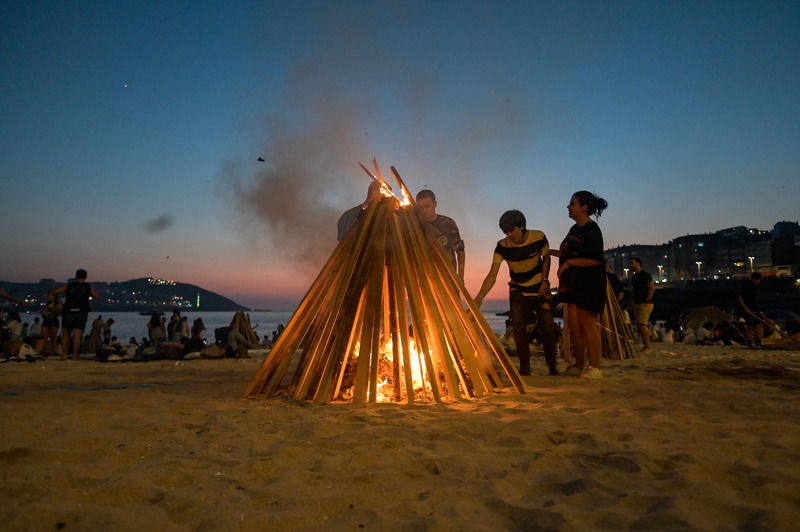
The Night of San Juan is one of the most magical and meaningful nights of the year, full of symbolism and traditions that have been preserved for centuries. It is celebrated from 23 to 24 June and coincides with the summer solstice and the birthday of St John the Baptist, giving it a special religious context.
Historical roots of the festival
San Juan has ancient roots dating back to the pagan era. The event is associated with the solar cult and rituals that are designed to ward off evil spirits, as well as to induce good luck and health. The first references to the holiday can be found in ancient Greek and Roman sources. A constant symbol of San Juan are the bonfires that are lit throughout the country, as well as water rituals aimed at purification.
In the treasury of Spanish culture, the feast of San Juan blends Christian and pagan traditions. Christians celebrate the day of St John the Baptist, who, according to legend, was born exactly six months earlier than Jesus Christ - 24 June.
However, many of the customs observed on this day have pagan roots, making San Juan a unique feast in the Spanish tradition.
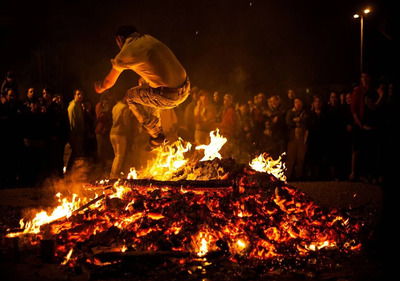
How the Feast of San Juan is celebrated
San Juan is celebrated on the night of 23-24 June. Typically, on the evening of 23 June all over Spain, people gather on beaches, parks and squares to build bonfires and burn old things in the fire, symbolising purification and renewal. Fire also symbolises the sun and the desire for warmth, light and protection from evil spirits.
The place of celebration depends on the region, as different cities have many unique traditions associated with the holiday.
On this night, people burn bonfires, jump over fire and immerse themselves in water, which symbolises purification and protection from negative energy. According to the rules, each action has its own rituals and omens, and those who wish can join these traditions to attract good luck.
Traditions and customs of the San Juan festival
On San Juan, the holiday is filled with colourful ceremonies that have been passed down from generation to generation. The main elements of the celebration include:
Bonfires and fires
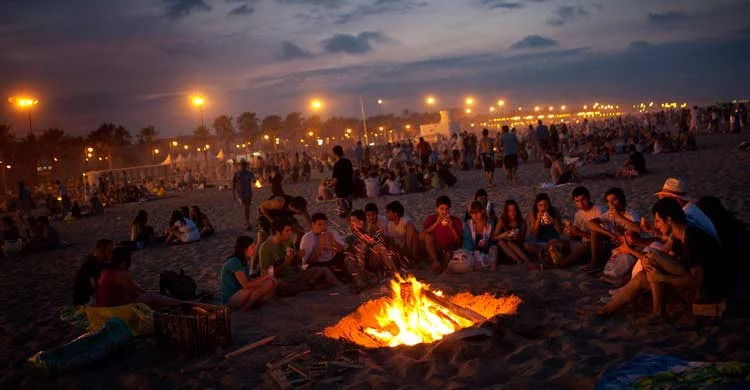 One of the most notable elements of the festival is the lighting of bonfires. Locals gather to take part in this ritual, and from early evening you can see the pillars of fire burning. The bonfires usually burn all night and people gather around them, singing songs and dancing.
One of the most notable elements of the festival is the lighting of bonfires. Locals gather to take part in this ritual, and from early evening you can see the pillars of fire burning. The bonfires usually burn all night and people gather around them, singing songs and dancing.
According to tradition, jumping over a bonfire is believed to bring good luck and purification. The more jumps, the more good luck, and, as they say, the easier it is to let go of the old and welcome the new.
Water rituals
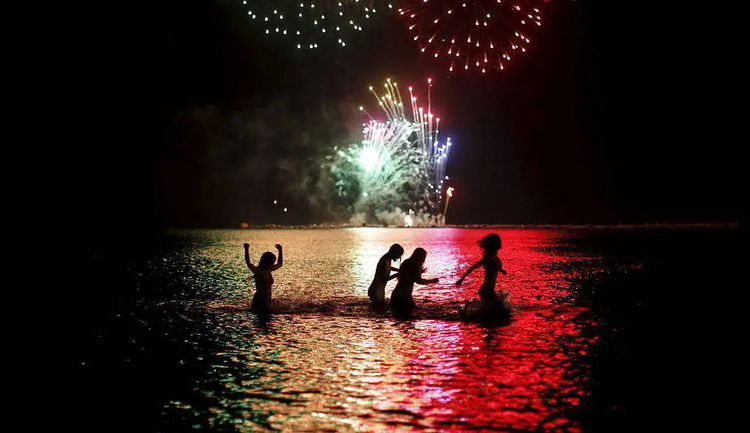 In addition to bonfires, water rituals are an important element of the festival. On this night it is believed that water has a special magical power. People go to rivers and seas to bathe and purify themselves. There is a belief that the first water you see this year will bring good luck for the next 12 months.
In addition to bonfires, water rituals are an important element of the festival. On this night it is believed that water has a special magical power. People go to rivers and seas to bathe and purify themselves. There is a belief that the first water you see this year will bring good luck for the next 12 months.
One of the rituals is jumping over the seven sea waves at midnight, which also brings good luck for the year ahead.
There is also a tradition of throwing flowers into the water. This symbolises letting go of old grudges and the intention to start a new life. Flowers floating downstream symbolise wishes that should come true.
Where the San Juan Festival is celebrated
The Feast of San Juan is celebrated in every corner of Spain, but each region has its own unique traditions. There are a number of places where the celebrations are particularly memorable.
Barcelona
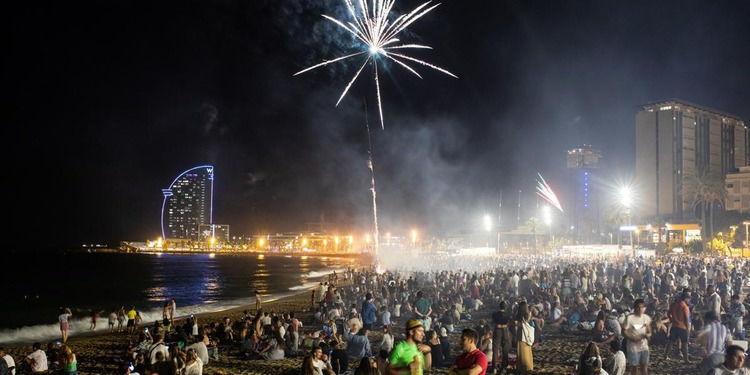 In Barcelona, San Juan is celebrated on a particularly large scale. Large bonfires are set up around the town and people gather on Barceloneta beach. Here you can find many tourists and locals singing, dancing and feasting. Bonfires on the beach create an atmosphere of fun, and a swim in the sea is considered a must for the celebrations.
In Barcelona, San Juan is celebrated on a particularly large scale. Large bonfires are set up around the town and people gather on Barceloneta beach. Here you can find many tourists and locals singing, dancing and feasting. Bonfires on the beach create an atmosphere of fun, and a swim in the sea is considered a must for the celebrations.
Valencia
In Valencia, the San Juan Festival has its own specialities. There are colourful fireworks displays that start as early as sunset. Bonfires and water also play an important role and many residents come to the beach to celebrate the night. It is also customary to use fireworks, which add dynamic and joy to the celebrations.
Alicante
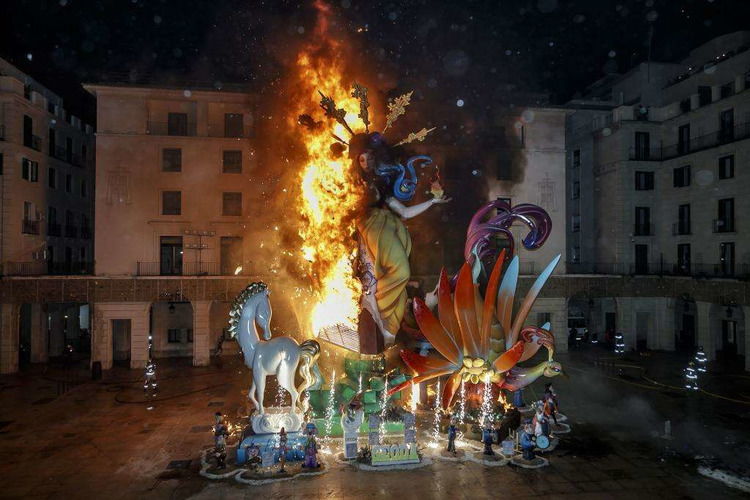 The San Juan festival in Alicante is celebrated in a special way - from 20 to 24 June, giant monuments (up to 12 metres high) made of wood, papier-mâché and cardboard, known in Alicante as ‘hogueras’, can be seen at the burning sites. They most often represent satirical or symbolic figures. The official hogueras can be found in Alicante's town hall square - they are always an impressive sight there! The other figures are simpler, but no less interesting!
The San Juan festival in Alicante is celebrated in a special way - from 20 to 24 June, giant monuments (up to 12 metres high) made of wood, papier-mâché and cardboard, known in Alicante as ‘hogueras’, can be seen at the burning sites. They most often represent satirical or symbolic figures. The official hogueras can be found in Alicante's town hall square - they are always an impressive sight there! The other figures are simpler, but no less interesting!
Sevilla
In Sevilla, the night of San Juan takes place in a more modest setting, but is no less colourful. Here, bonfires are created in the streets and the spirit of old traditions is preserved. Locals celebrate the festival in their backyards, cook delicious traditional dishes, throw parties and invite friends. Most often the main accent is on the musical accompaniment and dancing to the sounds of flamenco.
Granada
In Granada the festivities are filled with history and magic. Bonfires here are lit on high ground, offering a beautiful view of the city. There are many cultural rituals associated with the person who will jump over the bonfire. On this night, an artificial return to ancient traditions is often held here.
The Night of San Juan in Spain is not just a date on the calendar, but a real opportunity for people to come together, celebrate the beginning of summer and embrace the rich traditions of their country. Bonfires, water rituals and musical celebrations create a unique atmosphere that cannot be compared to anything else.
San Juan is a holiday that brings people together, encourages a spirit of unity and fun, and reminds us of the rich cultural traditions at the heart of Spanish society. It should be celebrated not only in Spain, but also abroad, as it reminds us of the importance of valuing our heritage and passing it on to the next generation.

 English
English  Español
Español  Русский
Русский